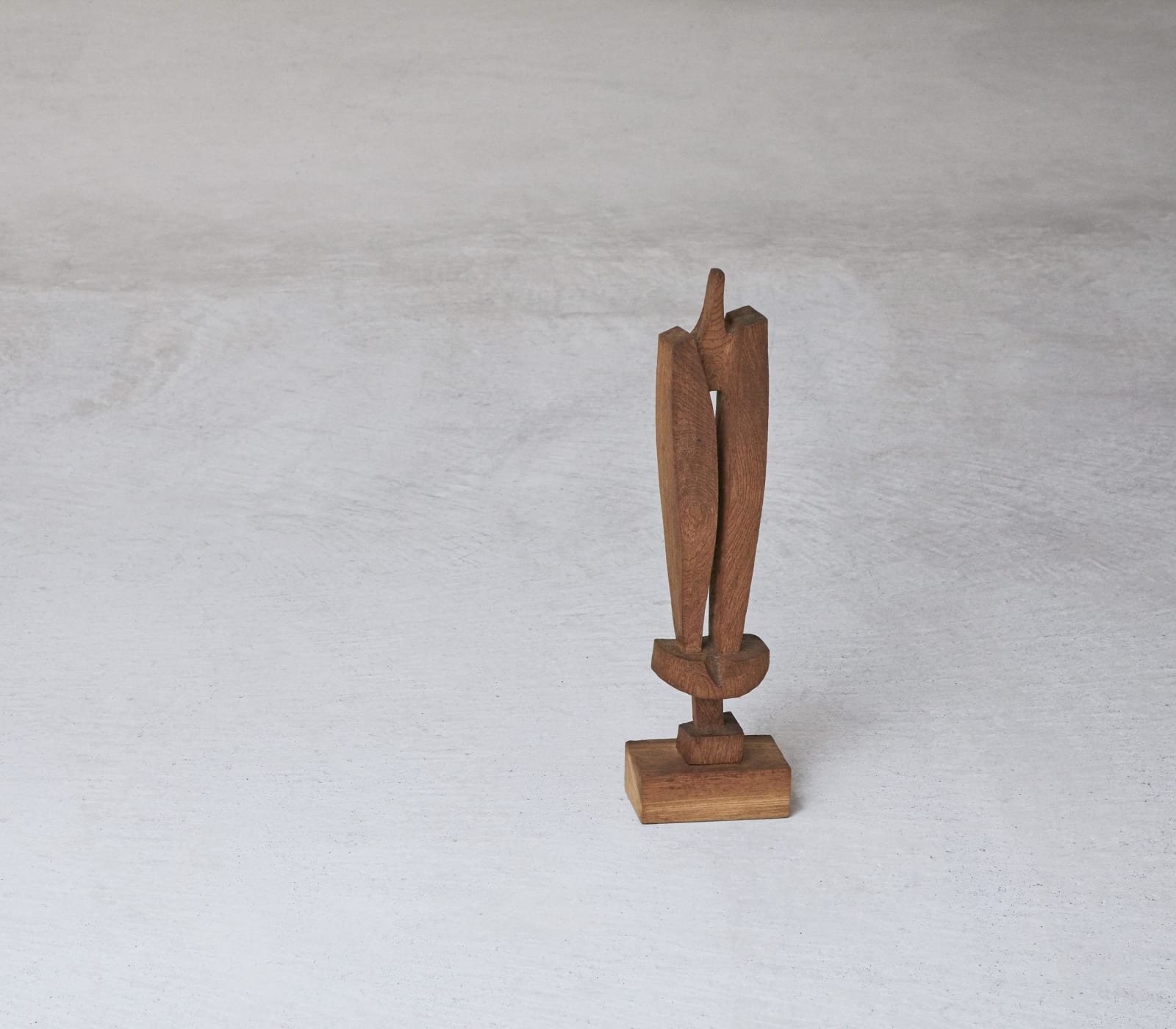Ueki Shigeru (1913–1984)
Woman
Wood
D8.5 x W11.3 x H41 cm
Ueki Shigueru began in 1935, at the age of twenty-two, to study sculpture as an autodidact. “I am entering into a dialogue with the wood,” he has once stated. As a result of these dialogues, the artist has produced a substantial number of torsos. Ueki engaged in more complete renderings of the body—the torso with limbs and a head—in the years from 1960 to 1962. More than emphasizing the simple torso, the artist explored beauty in the connection of the trunk, head, and limbs. The present work may not have arms, but it has legs and a head, and we infer from hollow space between the part corresponding to the hips that it shows a woman. The mass leading from the head to the shoulders is treated expressively to evoke a sense of beauty. Ueki has declared that “recently, I am fascinated by a female shape characterized by a certain imbalance between the parts of the body, such as hips or breast, very much in contradiction to the traditional ideas of well-balanced proportion. There is potential for beauty in those regarded not beautiful, while the conventionally beautiful woman for me is difficult to work with” (“More Unpolished, a Dry Kind of Beauty.” Yomiuri Shinbun, January 3, 1957).
Many of Ueki Shigeru’s works are titled Torso. Among them, the artist often rejects a too sensitive approach, opting instead for a forceful cut to express the work’s volume. According to Ueki, a good effort “reflects texture and grain of the wood, but also the way the blade cuts into the material, responding to light and relief of the surface in order to reveal the physical presence of the object. It suggests a boundless spatial expanse that penetrates the heart, and makes you feel like you just want to touch it” (“Carving the Wood.” Asahi Shimbun, November 29, 1960).
Most of Ueki’s works are based on such a reasoning, yet between Torso of 1960 and Child of 1962, the artist readjusts various aspects. He begins to add heads to those torsos which represent women and children, and emphasizes the head part for the latter, expanding his expressive range while remaining within the torso concept.
In the present work, the contours leading from the back of the head to the top of the shoulders, including the spine, are among Ueki’s most accomplished. There is an intentional imbalance of the plain woman’s body, as expressed in the differences of the fullness of the body from the left part of the chest to the right part of the belly. Moreover, Ueki also shows us glimpses of the spine one would normally not see. It is a work that adds significance to the space it creates. Considering this, it appears plausible that Woman dates to the era when Ueki began to add heads to his works around 1960. In the cautious attention paid to the natural quality of the wood and the treatment of the human form, the present work is representative for Ueki’s style.
Ueki Shigeru (sculptor; 1913–1984)
Sculptor from Hokkaido. Ueki studied with the Western-style painter Migishi Kotaro, but later turned towards sculpture, in which he was self-educated. He participated in the first exhibition of the Free Artists Association in 1937 and co-founded the Modern Art Association in 1950, though he left the group in 1954. Ueki gained recognition for his abstract or semi-abstract works, for which he used wood, bamboo or uncommon materials such as Japanese paper or plastic resin.
Many of Ueki Shigeru’s works are titled Torso. Among them, the artist often rejects a too sensitive approach, opting instead for a forceful cut to express the work’s volume. According to Ueki, a good effort “reflects texture and grain of the wood, but also the way the blade cuts into the material, responding to light and relief of the surface in order to reveal the physical presence of the object. It suggests a boundless spatial expanse that penetrates the heart, and makes you feel like you just want to touch it” (“Carving the Wood.” Asahi Shimbun, November 29, 1960).
Most of Ueki’s works are based on such a reasoning, yet between Torso of 1960 and Child of 1962, the artist readjusts various aspects. He begins to add heads to those torsos which represent women and children, and emphasizes the head part for the latter, expanding his expressive range while remaining within the torso concept.
In the present work, the contours leading from the back of the head to the top of the shoulders, including the spine, are among Ueki’s most accomplished. There is an intentional imbalance of the plain woman’s body, as expressed in the differences of the fullness of the body from the left part of the chest to the right part of the belly. Moreover, Ueki also shows us glimpses of the spine one would normally not see. It is a work that adds significance to the space it creates. Considering this, it appears plausible that Woman dates to the era when Ueki began to add heads to his works around 1960. In the cautious attention paid to the natural quality of the wood and the treatment of the human form, the present work is representative for Ueki’s style.
Ueki Shigeru (sculptor; 1913–1984)
Sculptor from Hokkaido. Ueki studied with the Western-style painter Migishi Kotaro, but later turned towards sculpture, in which he was self-educated. He participated in the first exhibition of the Free Artists Association in 1937 and co-founded the Modern Art Association in 1950, though he left the group in 1954. Ueki gained recognition for his abstract or semi-abstract works, for which he used wood, bamboo or uncommon materials such as Japanese paper or plastic resin.
